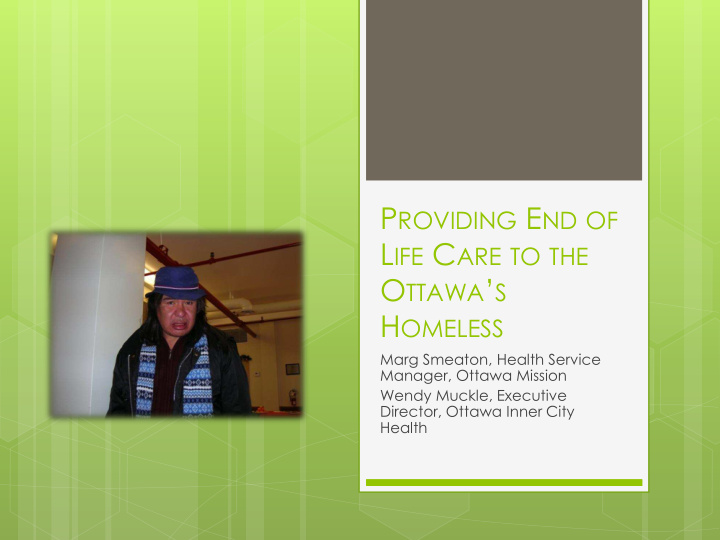



P ROVIDING E ND OF L IFE C ARE TO THE O TTAWA ’ S H OMELESS Marg Smeaton, Health Service Manager, Ottawa Mission Wendy Muckle, Executive Director, Ottawa Inner City Health
Age adjusted life expectancy 25-30 years less than housed Canadians Usually have had difficult lives, poor coping skills, Higher burden of illness Lack of natural caregiving systems, Lack of appropriate housing impedes benefit from health care Severe mental illness imposes complexity on plan of care Why the Homeless Have a Right to Palliative Care?
The meaning of Palliation? (of a treatment or medicine) relieving pain or alleviating a problem without dealing with the underlying cause “You Who deserves a good death more than someone who has had a difficult life ???
Benefits? Cost effective ($125 per day vs $3000 in hospital) Consistently demonstrated cost savings of $3:1 Significant reduction in ER utilization Longer life expectancy than in shelter or on the streets Reconnection to family and social supports (restoration of position in society)
Do you Need a Hospice? It’s nice but. . . Need to address the need by adherence to End of life care is values and not defined by succumb to “rules” meeting need and about palliative respecting life care choices not by a bundle of care
In the Beginning. . . .. Mission Hospice opened in 2001 at the height of the AIDS crisis Established to provide accessible palliative care to homeless Main barriers to accessing main stream palliative care were drug use and trajectory of the disease (AIDS)
Palliative Care Context Strongly rooted in middle class white values Efforts to differentiate palliative care from other kinds of health services have created certain “rules/norms” which define palliative care which may be at odds with values of the homeless Take the best and give back the rest. . . . Remember who we work for!
Challenges to the “Mainstream” Palliative Care System Culturally very different from what many providers are familiar with Value system often at odds with mainstream palliative world Poor tolerance for rules and rigid requirements Behavior and lifestyle may be at odds with care provider system and practices Lack of connection to usual “gate keepers” to access care Talking less important than “doing” Need for palliative care occurs much earlier in the disease trajectory
A Different Model of End of Life Care Initial response to the AIDS crisis among the homeless in 2000 Unbearable suffering of homeless people who use drugs led to Mission Hospice Vision of a place to live at the end of life which respected the life style and values which included their community “The Good Old Days”
What Did Our Clients Want? To Die within their own community and culture To have their lifestyle respected and accommodated To have dignity and to have their symptoms controlled To be remembered as important to their community
Meet Triple Therapy Hospice care shifted to cancer and chronic diseases Age of death increased HIV clinic changed the face of AIDS for the homeless But, people now living longer but living with more diseases and therefore more suffering Success from a survivalist lens but failure from a quality of life perspective
?? The Unknown Challenges to Palliative Providers??? When “the surprise question” applies to almost everybody When the trajectories of different disease processes fail to fit in the graph
Evidence and Data Validation of the SPICT tool in our setting demonstrated potential benefits to developing a chronic palliative care program Lacks sensitivity to complexity imposed by mental illness and lack of housing Many of the tools and measures commonly used in mainstream palliative care are not very useful in the homeless setting
A Different Model of End of Life Care? Care based on need to reduce suffering not on life expectancy Trajectory is flexible-not just one chance for end of life care Focus on living well and dying when other options are exhausted??
Rooted in Values of Compassion and Respect for Respect for Street Culture
What Is Street Culture? Lack of faith in police Rooted in alienation from and justice system mainstream society which often translates Automatic assumption of to other mainstream discrimination systems Lack of hope for a brighter Primary issue is respect - future hard won, easily lost Survivalist values and highly valued Inclination to violence as Lack of fear of dying, a way of solving conflict could die at any time Adhering to “Code of the and accept this as Street” normal – high tolerance for risk
What imposes suffering on the lives of our patients What can “we” do to minimize suffering and extend quality of life and longevity Challenge of how to integrate chronic palliative care in a resource limited setting Focus on Suffering
End of Life Care-the Next Generation. . 14 Acute palliative care beds 7 chronic palliative care beds Enhanced chronic palliative care services in supportive housing Health literacy project to engage clients in improving their own health outcomes
Take Home Message The benefits of end of life care to the homeless need to be defined by need vs models of care or funding End of life care needs to part of the care provided to people who are or have been homeless Benefits to individual obvious, benefits to health care system, community, family (especially children) less apparent but just as important
Recommend
More recommend